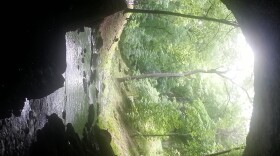Henry Rowe Schoolcraft’s journey through the Ozarks was just a “blip” in his lengthy exploration career, explains Trevor Harris, a journalist who’s hosting a program this week and producing an upcoming radio series on the 19th Century voyager.
Yet the journal written by Schoolcraft documenting his trip from Potosi, Missouri down through what is now Springfield in the winter of 1818 and 1819 has revealed a lot about the history of this region.
“So I read this [Schoolcraft’s] book and was very interested in the description of a Missouri that doesn’t exist anymore. Yeah the landforms are generally there, but the species mix has changed so much, and I was interested specifically in the forces of that change,” says Harris.
Harris is an on-air announcer and producer for KBIA, the public radio station in Columbia. Last year, the station was awarded a grant from the Missouri Humanities Council to fund a series on Schoolcraft’s journey.
“I approached them [Humanities Council] a little bit less than a year ago and they generously funded the project, as did Missouri Life Magazine, and the Missouri Department of Conservation has been a main partner as well in the project.”
Harris, a lifelong Missourian, says he’s always been interested in the state’s culture and history. As part of a book club he belongs to, Harris read Schoolcraft’s journal for the first time last year. That sparked his desire to retrace some of Schoolcraft’s steps to learn more about his journey and find out what has changed.
Based on interviews from academics and saw mill operators to cattle ranches and environmental activist, Harris’ three-part series will highlight three different geographies along Schoolcraft’s walk.
“He started in the St. François Mountains near Potosi; he crossed over into the White River Valley heading to the south and the west. He ended up in the James River Valley, after briefly getting lost, he was at Springfield – or what he called Kickapoo Prairie, looking at some very rudimentary mines that were operating in the area. And then he began his trip back, and that was no small affair too,” said Harris.
Harris visited Potosi, Springfield and West Plains to collect interviews for his story, which will discussed in this Thursday's program in Springfield and examined in an upcoming 3-part radio series. While modern day West Plains was not along Schoolcraft’s route, Harris says the population base there allowed opportunities to obtain stories about Schoolcraft and collect data.
Harris says it’s been fascinating to red, and in his research also hear about the landscape and lifestyle of this region some 200 years ago. Since then, about six million more people have inhabited this area of Missouri, he says.
“As we keep being more and more of us, I think it’s important to know what existed before so that those remaining pieces of land that we have saved and either purchased for the public or intelligent land owners are protecting them, a book like Schoolcraft’s journal can be a good guide to know what was the pre-settlement condition like, and how can that inform what we work toward replicating or rebuilding on our landscapes.”
Harris notes that Schoolcraft’s visit through the Ozarks was just a “blip,” lasting several months. He would later go on to explore parts of the Great Lakes region.
On Thursday, the Springfield Conservation Nature Center hosts The Landscapes of Henry Rowe Schoolcraft. The event features officials with the Missouri Department of Conservation discussing natural history and changes to the landscape since his journey, as well as Schoolcraft re-enactor Dr. Bob Kipfer. Kipfer, who lives on a property once traveled by Henry Schoolcraft, was the subject of a 2015 report by KSMU. Also view our report on Schoolcraft's journey near Smallin Cave.
Thursday’s event begins at 7 pm and is free and open to the public, but registration is required. Call 417-888-4237 for more information.




